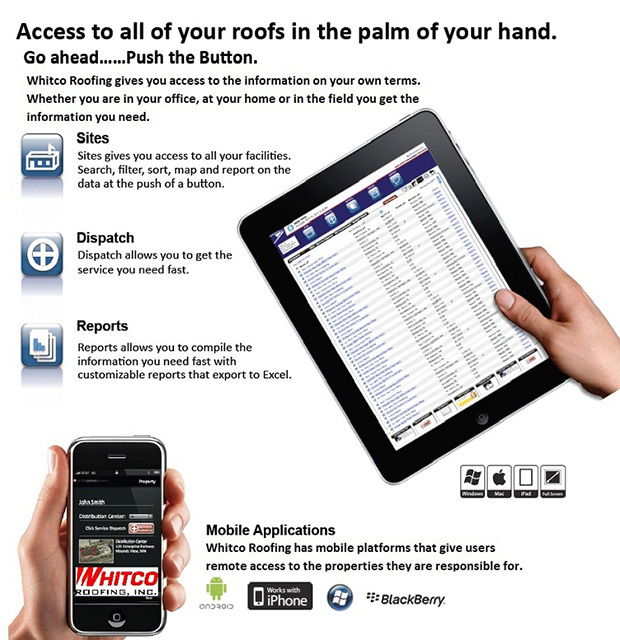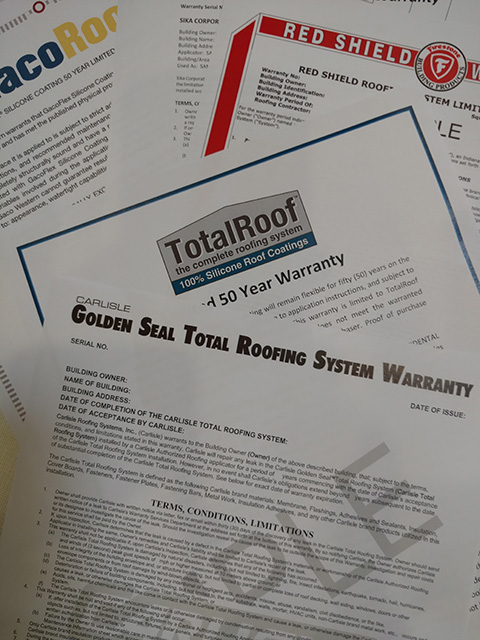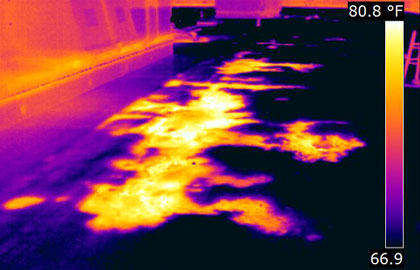Roof Asset Management
A roof is not just an integral part of your building, it’s an investment — and a costly one. Roof asset management is how Whitco helps clients maintain and maximize their investments. Repairing a leak is one example of roof asset management, but there’s much more to it than that. There are three key areas of roof asset management that you as a building owner need to understand: roof inventory, record keeping, and preventive maintenance.
![]()
Roof Inventory
The first step to protecting your roof is having all the information you can about it. Roof inventory includes knowing what type of roofing system a building has, the type and thickness of insulation and membrane, and the easiest way to access the roof for maintenance. It is difficult to manage the life-cycle of a roof if you don’t know the details of your roof system and what to expect from it. Maintaining an up-to-date inventory of all buildings and their roof systems is vital in maintaining roofing assets. Having this information ready will be important if and when your roof needs service.
![]()
Record Keeping
To support your roof inventory, it’s important to keep good records. When was your roof system installed? When was the last time your roof was serviced? When does your roof warranty expire? The answers to these questions help inform your maintenance decisions and make it easy to provide your roofing contractor with pertinent information. Once you have these answers compiled, be sure to add information on the maintenance of your roofing systems as it becomes available.
![]()
Preventive Maintenance
After the initial roof installation, it’s pertinent to be aware of your roof’s preventative maintenance needs and schedule. Preventive maintenance keeps your roof in good working condition and prevents small issues from becoming costly major issues. You wouldn’t buy a new vehicle and neglect to change the oil. Preventive maintenance is the “oil” that keeps a roof functioning as it should. Roof warranties call for regular maintenance in order to keep the warranty current and effective. Many manufacturers require that this maintenance be documented, something Whitco’s cloud-based Whitcommand can assist clients with.
Inadequate roof maintenance can lead to premature failure. This exposes your building to water damage, potentially wreaking havoc on your people, equipment, and productivity. A preventive maintenance program will minimize leaks, keep structural components in sound condition, and keep the roofing insulation dry. This strategy increases the likelihood that insulation can be “re-used” during the next installation. This reduces the cost of the second installation by 30 to 40 percent, and helps prevent unnecessary waste.
Overall, it’s important to know that preventive maintenance increases the life of a roof by as much as 50 percent, reduces roof-related expenses and subsequent damages, freeing up capital for other uses, and cuts the time and effort required to address emergency repairs. Implementing a regular roof maintenance program is critical to validating the warranty, prolonging the life, avoiding failure of a commercial roof, and reducing liabilities related to roof leaks.
![]()
Roof Infrared Scans
Identifying and repairing areas of weakness is an important part of preventive maintenance. Some roof issues, including moisture penetration, heat-loss areas, and related building envelope deficiencies, can be identified using roof infrared scanning technology. These problems aren’t always visible to the naked eye, so Whitco uses infrared and other leak and moisture detection technologies, such as Electric Field Vector Mapping and nuclear scans, to ensure your roof’s long-term health is being addressed.
Whitco’s rooftop energy management experts use this technology to capture a thermal image of your roof, identifying pockets of wet insulation that could be causing severe energy loss. This allows technicians to properly repair and restore your system to its original level of energy efficiency. To provide your roof with effective preventative maintenance, Whitco utilizes infrared scans to detect problems before they occur. This effectively prevents small problems from becoming large and costly.
An Infrared Roof Scan can:
- Detect roof leaks, by identifying pockets of saturated insulation
- Illustrate the full impact of past leaks
- Identify areas of energy loss
- Help building owners find the optimum solution to stop leaks




